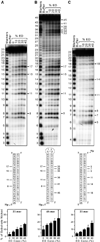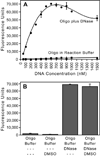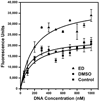A nonradioactive plate-based assay for stimulators of nonspecific DNA nicking by HIV-1 integrase and other nucleases
- PMID: 19748478
- PMCID: PMC2787845
- DOI: 10.1016/j.ab.2009.09.012
A nonradioactive plate-based assay for stimulators of nonspecific DNA nicking by HIV-1 integrase and other nucleases
Abstract
Retroviral integrase enzymes have a nonspecific endonuclease activity that is stimulated by certain compounds, suggesting that integrase could be manipulated to damage viral DNA. To identify integrase stimulator (IS) compounds as potential antiviral agents, we have developed a nonradioactive assay that is suitable for high-throughput screening. The assay uses a 49-mer oligonucleotide that is 5'-labeled with a fluorophore, 3'-tagged with a quencher, and designed to form a hairpin that mimics radioactive double-stranded substrates in gel-based nicking assays. Reactions in 384-well plates are analyzed on a real-time PCR machine after a single heat denaturation and subsequent cooling to a point between the melting temperatures of unnicked substrate and nicked products (no cycling is required). Under these conditions, unnicked DNA reforms the hairpin and quenches fluorescence, whereas completely nicked DNA yields a large signal. The assay was linear with time, stimulator concentration, and amount of integrase, and 20% concentrations of the solvent used for many chemical libraries did not interfere with the assay. The assay had an excellent Z' factor, and it reliably detected known IS compounds. This assay, which is adaptable to other nonspecific nucleases, will be useful for identifying additional IS compounds to develop the novel antiviral strategy of stimulating integrase to destroy retroviral DNA.
Figures






Similar articles
-
Evaluation of a system to screen for stimulators of non-specific DNA nicking by HIV-1 integrase: application to a library of 50,000 compounds.Antivir Chem Chemother. 2011 Oct 7;22(2):67-74. doi: 10.3851/IMP1857. Antivir Chem Chemother. 2011. PMID: 21984686 Free PMC article.
-
Alternative nucleophilic substrates for the endonuclease activities of human immunodeficiency virus type 1 integrase.Virology. 2012 Nov 10;433(1):149-56. doi: 10.1016/j.virol.2012.07.022. Epub 2012 Aug 19. Virology. 2012. PMID: 22910593 Free PMC article.
-
Development of a fluorescence-based HIV-1 integrase DNA binding assay for identification of novel HIV-1 integrase inhibitors.Antiviral Res. 2013 Jun;98(3):441-8. doi: 10.1016/j.antiviral.2013.04.001. Epub 2013 Apr 9. Antiviral Res. 2013. PMID: 23583286
-
Oligonucleotide-based assays for integrase activity.Methods. 2009 Apr;47(4):243-8. doi: 10.1016/j.ymeth.2008.10.024. Epub 2008 Nov 14. Methods. 2009. PMID: 19010419 Free PMC article. Review.
-
Novel therapeutic strategies targeting HIV integrase.BMC Med. 2012 Apr 12;10:34. doi: 10.1186/1741-7015-10-34. BMC Med. 2012. PMID: 22498430 Free PMC article. Review.
Cited by
-
Evaluation of a system to screen for stimulators of non-specific DNA nicking by HIV-1 integrase: application to a library of 50,000 compounds.Antivir Chem Chemother. 2011 Oct 7;22(2):67-74. doi: 10.3851/IMP1857. Antivir Chem Chemother. 2011. PMID: 21984686 Free PMC article.
-
Alternative nucleophilic substrates for the endonuclease activities of human immunodeficiency virus type 1 integrase.Virology. 2012 Nov 10;433(1):149-56. doi: 10.1016/j.virol.2012.07.022. Epub 2012 Aug 19. Virology. 2012. PMID: 22910593 Free PMC article.
References
-
- Craigie R. HIV integrase, a brief overview from chemistry to therapeutics. J. Biol. Chem. 2001;276:23213–23216. - PubMed
-
- Brown PO. Integration. In: Coffin JM, Hughes SH, Varmus HE, editors. Retroviruses. Cold Spring Harbor, New York: Cold Spring Harbor Laboratory Press; 1997. pp. 161–203.
-
- Havlir DV. HIV integrase inhibitors--out of the pipeline and into the clinic. N. Engl. J. Med. 2008;359:416–418. - PubMed
-
- Skinner LM, Sudol M, Harper AL, Katzman M. Nucleophile selection for the endonuclease activities of human, ovine, and avian retroviral integrases. J. Biol. Chem. 2001;276:114–124. - PubMed
Publication types
MeSH terms
Substances
Grants and funding
LinkOut - more resources
Full Text Sources
Miscellaneous

